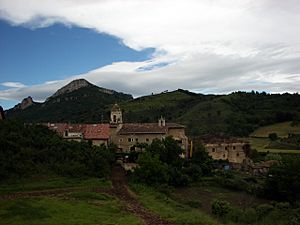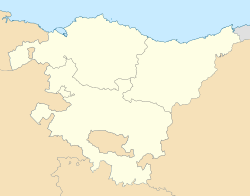Bujanda facts for kids
Quick facts for kids
Bujanda
|
|
|---|---|
|
Village
|
|
 |
|
| Country | Spain |
| Autonomous community | Basque Country |
| Province | Álava |
| Comarca | Montaña Alavesa |
| Municipality | Campezo |
| Elevation | 615 m (2,018 ft) |
| Population
(2014)
|
|
| • Total | 19 |
| Demonym(s) | bujandés, charrín |
| Time zone | UTC+1 (CET) |
| • Summer (DST) | UTC+2 (CEST) |
| Postal code |
01128
|
| Official language(s) | Spanish Basque (Euskera) |
Bujanda is a small village located in Álava, part of the Basque Country in Spain. It's known for its old church, which holds the special remains of a saint named San Fausto Labrador. This made the village quite famous in the past.
At its busiest, Bujanda had about 150 people living there. However, many people moved away in the 1960s, causing the population to shrink a lot. Today, Bujanda is focusing on activities like culture, sports, and nature. This is because it's close to interesting places like Antoñana, a medieval walled village, and the beautiful Nature Park of Izki. It's also near greenways, mountain bike trails, and hiking paths. Other nearby attractions include Merindad de Estella, Treviño, Rioja, and the Basque Coast.
Contents
What's in a Name?
The name of Bujanda has changed over time. The first time it was written down, in the year 1071, it appeared as Buszanda. Later, in other old records, it was called Buxanda.
Eventually, the "x" sound changed to the "j" sound we use today. This is how it became Bujanda, its current official name. The name might mean "place of boxwood" because it comes from the Latin word buxus (which means boxwood) and a suffix -anda that means "place of".
Where is Bujanda?
Bujanda is located in a valley near the top of the Ega River. It sits about 615 meters (2,018 feet) above sea level. You can find it on the eastern side of the Muela mountain, which is 1,059 meters (3,474 feet) tall.
The village is right at the southern edge of the Nature Park of Izki. Bujanda is 7 kilometers (4.3 miles) from Santa Cruz de Campezo, which is the main town of the area. It's also about 36 kilometers (22 miles) from Vitoria, the capital of Alava. Other nearby cities include Estella (35 kilometers or 22 miles away) and Logroño (40 kilometers or 25 miles away).
- Altitude: 615 meters (2,018 feet)
- Latitude: 42°40'25" N
- Longitude: 2º24'19" W
Getting Around
If you want to visit Bujanda, you can take a bus. There are bus routes from Vitoria to Estella and from Vitoria to Calahorra. These buses stop in Antoñana, which is only about 3 kilometers (1.9 miles) from Bujanda.
How Many People Live Here?
In 1960, Bujanda had 97 residents. But after that, the number of people living in the village dropped a lot. In just fifteen years, the population fell by two-thirds.
By 1975, there were only 34 people. This number kept going down, reaching its lowest point in 2008 with just 16 people (11 men and 5 women). The most recent information from 2014 shows a slight increase, with 19 people living in Bujanda (14 men and 5 women).
Here's how the population has changed over the years:
- In the late 1500s: 75 people
- In the late 1700s: 100 people
- In the mid-1800s: 150 people
- In 1900: 124 people
- In 1930: 113 people
- In 1960: 97 people
- In 2008: 16 people
- In 2014: 19 people
How Bujanda is Governed
Bujanda has its own mayor, who is chosen by the people living in the village. The last time they voted for a mayor was in December 2013. The person who won received four votes.
Bujanda is part of a larger area called the municipality of Campezo. This municipality also includes other villages like Antoñana, Oteo, Orbiso, and Santa Cruz de Campezo.
Festivals and Traditions
The Story of San Fausto Labrador
San Fausto Labrador was a very kind person who lived a long time ago. He was born in a place called Alguaire in Catalonia, Spain. From a young age, he dedicated his life to helping people who were poor and in need.
One day, while traveling, he was captured by the Saracens and became a slave. His master would beat him whenever he saw him praying. But something amazing happened! One day, his master was shocked to see the farm tools working by themselves while San Fausto was praying. This miracle convinced the master, and San Fausto baptized him.
After that, San Fausto and his former master traveled back to Alguaire. When San Fausto was close to death, around the year 614, he told his family and friends something special. He asked them to place his body on his horse after he died. He said they should leave his body wherever God led the horse. His family and friends followed his wishes, and the horse eventually stopped in Bujanda. That's why his remains are still in the church there today.
Many villages honor San Fausto Labrador with prayers and celebrations:
- Antoñana, San Roman, Corres, and Bujanda (these four villages have a special agreement to celebrate together)
- Rosselló (Lleida), after Easter
- Iruraiz-Gauna (Llanada Alavesa), on a Saturday in September
- Valles de Laminoria and Arraya
- Orbiso, on the Day of San Prudencio
- Ancín (Navarra), on the day of San Isidro
- Genevilla (Navarra), on the last Sunday in May
- Apellániz (valle de Arraya), on Pentecost Sunday
- Santa Cruz de Campezo
- Barriobusto (Rioja Alavesa), on the Sunday before Pentecost
- Labraza (Rioja Alavesa), on Pentecost Sunday
- Quintana, on the Sunday after Corpus Christi
- Alguaire (Lleida), on the first Sunday of July
Village Festivities
Bujanda celebrates its main festival on the first weekend of October. It's a fun time with lots of activities for everyone!
- Friday
- The festival kicks off with an opening speech and fireworks.
- Everyone enjoys a big community dinner together.
- Saturday
- People hike up Mount Soila.
- There's a special Mass.
- A popular "Chorizada" takes place, where everyone enjoys grilled sausages.
- Card game championships are held: "brisca" for women and "mus" for men.
- There's a costume competition where people dress up.
- A "chocolatada" offers delicious hot chocolate.
- The day ends with a "Verbena," which is a lively outdoor party with music and dancing.
- Sunday
- The day starts with "pasacalles" dancing in the streets.
- A special Mass of Concord is held, bringing together people from San Roman, Corres, Antoñana, and Bujanda.
- Kids can enjoy an inflatable castle.
- The final rounds of the card championships (brisca and mus) are played.
- There are also other games for children.
Images for kids
See also
 In Spanish: Bujanda para niños
In Spanish: Bujanda para niños




